Optimising Farm Area Allocations Based on Soil Moisture Thresholds: A Comparative Study of Two Dairy Farms with Distinct Soil and Topographic Features
Abstract
1. Introduction
2. Materials and Methods
2.1. Site Selection and Characteristics
2.2. Determining Soil Moisture Thresholds (SMTs) for Trafficability and Optimum Crop Growth
2.3. Ancillary Data
3. Results
3.1. Soil Moisture Thresholds
3.2. Patterns of nSSM on the Farms
3.3. Proportion of Farm Area in the Favourable SMT
3.4. Comparison of Trends in Farm Area Proportion and Grass Growth Trends
4. Discussion
5. Conclusions
Supplementary Materials
Author Contributions
Funding
Institutional Review Board Statement
Data Availability Statement
Acknowledgments
Conflicts of Interest
References
- ECMWF. ECMWF Copernicus Global Climate Highlights. 2023. Available online: https://climate.copernicus.eu/gch-2023-press-resources (accessed on 3 April 2025).
- Copernicus Climate Change Service. Copernicus: 2020 Warmest Year on Record for Europe; Globally, 2020 Ties with 2016 for Warmest Year Recorded. Available online: https://climate.copernicus.eu/copernicus-2020-warmest-year-record-europe-globally-2020-ties-2016-warmest-year-recorded (accessed on 15 January 2025).
- Nations, U. A Year of Climate Contrasts in Europe. 2023. Available online: https://unric.org/en/2023-a-year-of-climate-contrasts-in-europe/ (accessed on 3 April 2025).
- Copernicus Climate Change Service Europe State of The Climate 2023. 2023. Available online: https://climate.copernicus.eu/sites/default/files/custom-uploads/ESOTC%202023/Summary_ESOTC2023.pdf (accessed on 22 April 2024).
- Met Eireann Annual Climate Statement for 2023. Available online: https://www.met.ie/annual-climate-statement-for-2023 (accessed on 12 April 2025).
- Almendra-Martin, L.; Martinez-Fernandez, J.; Piles, M.; Gonzalez-Zamora, A.; Benito-Verdugo, P.; Gaona, J. Analysis of Soil Moisture Trends in Europe Using Rank-Based and Empirical Decomposition Approaches. Glob. Planet. Chang. 2022, 215, 103868. [Google Scholar] [CrossRef]
- EPA. What Impact Will Climate Change Have on Ireland. Available online: https://www.epa.ie/environment-and-you/climate-change/what-impact-will-climate-change-have-for-ireland/#d.en.84746 (accessed on 1 February 2025).
- Met Eireann Provisonal State of the Irish Climate Report. 2023. Available online: https://www.met.ie/state-of-the-irish-climate-report-2023 (accessed on 12 December 2024).
- Met Eireann Ireland’s 30 Year Climate Averages. Available online: https://www.met.ie/climate/30-year-averages (accessed on 5 February 2025).
- Lennon, J.J. Potential Impacts of Climate Change on Agriculture and Food Safety Within the Island of Ireland. Trends Food Sci. Technol. 2015, 44, 1–10. [Google Scholar] [CrossRef]
- EPA. Ireland’s Climate Change Assessment Syntheis Report. Available online: https://www.epa.ie/publications/monitoring--assessment/climate-change/ICCA_Synthesis_Report.pdf (accessed on 8 January 2025).
- Sweeney, J. Climate Change in Ireland: Science, Impacts and Adaptation. In Palgrave Studies in Media and Environmental Communication; Palgrave Macmillan: Cham, Switzerland, 2020; pp. 15–36. ISBN 978-3-030-47587-1. [Google Scholar]
- Teagasc Moorepark Dairy Levy Research Update Teagasc Heavy Soils Programme—Lessons Learned—A Guide to the Key Findings of the Teagasc Heavy Soils Programme to-Date. Available online: https://www.teagasc.ie/media/website/animals/dairy/Heavy-Soils-Lessons-Learned.pdf (accessed on 9 December 2022).
- Lepore, E.; Schmidt, O.; Fenton, O.; Tracy, S.; Bondi, G.; Wall, D. Moisture Limits for Grassland Soil to Avoid Structural Damage Due to Machine Trafficking. In Proceedings of the EGU23, Copernicus Meetings. Vienna, Austria, 22 February 2023. [Google Scholar]
- Forristal, D. Managing Wet and Weak Soils. Available online: https://www.teagasc.ie/media/website/environment/soil/Teagasc_Drainage_Manual_2022.pdf (accessed on 5 February 2025).
- Tuohy, P.; Humphreys, J.; Holden, N.; O’Loughlin, J.; Reidy, B.; Fenton, O. Visual Drainage Assessment: A Standardized Visual Soil Assessment Method for Use in Land Drainage Design in Ireland. In Proceedings of the 2016 10th International Drainage Symposium Conference, Minneapolis, MN, USA, 6–9 September 2016. [Google Scholar]
- Nanda, A.; Das, N.; Singh, G.; Bindlish, R.; Andreadis, K.M.; Jayasinghe, S. Harnessing SMAP Satellite Soil Moisture Product to Optimize Soil Properties to Improve Water Resource Management for Agriculture. Agric. Water Manag. 2024, 300, 108918. [Google Scholar] [CrossRef]
- Furtak, K.; Wolińska, A. The Impact of Extreme Weather Events as a Consequence of Climate Change on the Soil Moisture and on the Quality of the Soil Environment and Agriculture—A Review. Catena 2023, 231, 107378. [Google Scholar] [CrossRef]
- Chatterjee, S.; Desai, A.R.; Zhu, J.; Townsend, P.A.; Huang, J. Soil Moisture as an Essential Component for Delineating and Forecasting Agricultural Rather than Meteorological Drought. Remote Sens. Environ. 2022, 269, 112833. [Google Scholar] [CrossRef]
- Basu, R.; Daly, E.; Brown, C.; Shnel, A.; Tuohy, P. Temporal Stability of Grassland Soil Moisture Utilising Sentinel-2 Satellites and Sparse Ground-Based Sensor Networks. Remote Sens. 2024, 16, 220. [Google Scholar] [CrossRef]
- Basu, R.; Fenton, O.; Daly, E.; Tuohy, P. Identifying Favourable Conditions for Farm Scale Trafficability and Grass Growth Using a Combined Sentinel-2 and Soil Moisture Deficit Approach. Front. Environ. Sci. 2024, 12, 1331659. [Google Scholar] [CrossRef]
- Arosio, R.; Wheeler, A.J.; Sacchetti, F.; Guinan, J.; Benetti, S.; O’Keeffe, E.; van Landeghem, J.J.K.; Conti, L.A.; Furey, T.; Lim, A. The Geomorphology of Ireland’s Continental Shelf. J. Maps 2023, 19, 2283192. [Google Scholar] [CrossRef]
- Environmental Protection Agency Irish Soil Information System Synthesis Report. 2014. Available online: https://www.epa.ie/publications/research/land-use-soils-and-transport/EPA-RR130-WEB.pdf (accessed on 17 April 2025).
- Carlier, J.; Doyle, M.; Finn, J.A.; Ó hUallacháin, D.; Moran, J. A Landscape Classification Map of Ireland and Its Potential Use in National Land Use Monitoring. J. Environ. Manag. 2021, 289, 112498. [Google Scholar] [CrossRef]
- Simo, I.; Creamer, R.E.; Reidy, B.; Jahns, G.; Massey, P.; Hamilton, B.; Hannam, J.A.; McDonald, E.; Sills, P.; Spaargaren, O. Irish Soil Information System. 2008. Available online: http://gis.teagasc.ie/soils/ (accessed on 17 April 2025).
- Sensoterra Single Depth Sensor|Sensoterra. Available online: https://www.sensoterra.com/en/product/single-depth-sensor/ (accessed on 13 October 2022).
- Sadeghi, M.; Babaeian, E.; Tuller, M.; Jones, S.B. The Optical Trapezoid Model: A Novel Approach to Remote Sensing of Soil Moisture Applied to Sentinel-2 and Landsat-8 Observations. Remote Sens. Environ. 2017, 198, 52–68. [Google Scholar] [CrossRef]
- Schulte, R.P.O.; Simo, I.; Creamer, R.E.; Holden, N.M. A Note on the Hybrid Soil Moisture Deficit Model v2.0. Irish J. Agric. Food Res. 2015, 54, 128–131. [Google Scholar] [CrossRef]
- Hanrahan, L.; Geoghegan, A.; O’Donovan, M.; Griffith, V.; Ruelle, E.; Wallace, M.; Shalloo, L. PastureBase Ireland: A Grassland Decision Support System and National Database. Comput. Electron. Agric. 2017, 136, 193–201. [Google Scholar] [CrossRef]
- Vero, S.E.; Antille, D.L.; Lalor, S.T.J.; Holden, N.M. Field Evaluation of Soil Moisture Deficit Thresholds for Limits to Trafficability with Slurry Spreading Equipment on Grassland. Soil Use Manag. 2014, 30, 69–77. [Google Scholar] [CrossRef]
- Teagasc Environment—Fertiliser Advice under Prolonged Dry Soil Conditions—Teagasc|Agriculture and Food Development Authority. Available online: https://www.teagasc.ie/news--events/daily/environment/fertiliser-advice-under-prolonged-dry-soil-conditions.php (accessed on 19 June 2023).
- Lepore, E.; Schmidt, O.; Fenton, O.; Tracy, S.; Bondi, G.; Wall, D.P. Traffic Induced Compaction and Physical Quality of Grassland Soil under Different Soil Moisture Deficits. Soil Tillage Res. 2024, 244, 106205. [Google Scholar] [CrossRef]
- Hanrahan, L.; McHugh, N.; Hennessy, T.; Moran, B.; Kearney, R.; Wallace, M.; Shalloo, L. Factors Associated with Profitability in Pasture-Based Systems of Milk Production. J. Dairy Sci. 2018, 101, 5474–5485. [Google Scholar] [CrossRef] [PubMed]
- Läpple, D.; Hennessy, T.; O’Donovan, M. Extended Grazing: A Detailed Analysis of Irish Dairy Farms. J. Dairy Sci. 2012, 95, 188–195. [Google Scholar] [CrossRef] [PubMed]
- Palma-Molina, P.; Hennessy, T.; Dillon, E.; Onakuse, S.; Moran, B.; Shalloo, L. Evaluating the Effects of Grass Management Technologies on the Physical, Environmental, and Financial Performance of Irish Pasture-Based Dairy Farms. J. Dairy Sci. 2023, 106, 6249–6262. [Google Scholar] [CrossRef]
- Phelan, P.; Keogh, B.; Casey, I.A.; Necpalova, M.; Humphreys, J. The Effects of Treading by Dairy Cows on Soil Properties and Herbage Production for Three White Clover-Based Grazing Systems on a Clay Loam Soil. Grass Forage Sci. 2012, 68, 548–563. [Google Scholar] [CrossRef]
- Fenger, F.; Casey, I.A.; Holden, N.M.; Humphereys, J. Access Time to Pasture under Wet Soil Conditions: Effects on Productivity and Profitability of Pasture-Based Dairying. J. Dairy Sci. 2022, 105, 4189–4205. [Google Scholar] [CrossRef]
- Beukes, P.; Romera, A.; Clark, D.; Dalley, D.; Hedley, M.; Horne, D.; Monaghan, R.; Laurenson, S. Evaluating the Benefits of Standing Cows off Pasture to Avoid Soil Pugging Damage in Two Dairy Farming Regions of New Zealand. N. Z. J. Agric. Res. 2013, 56, 224–238. [Google Scholar] [CrossRef]
- Gardiner, M.J.; Radford, T. Soil Associations of Ireland and Their Land Use Potential. 1964. Available online: https://www.teagasc.ie/media/website/environment/soil/General.pdf (accessed on 17 April 2025).
- Lee, J.; Ryan, M. A Clinosequence of Soils Associated with Drumlin Landscape. Ir. J. Agric. Res. 1965, 4, 1–12. [Google Scholar]

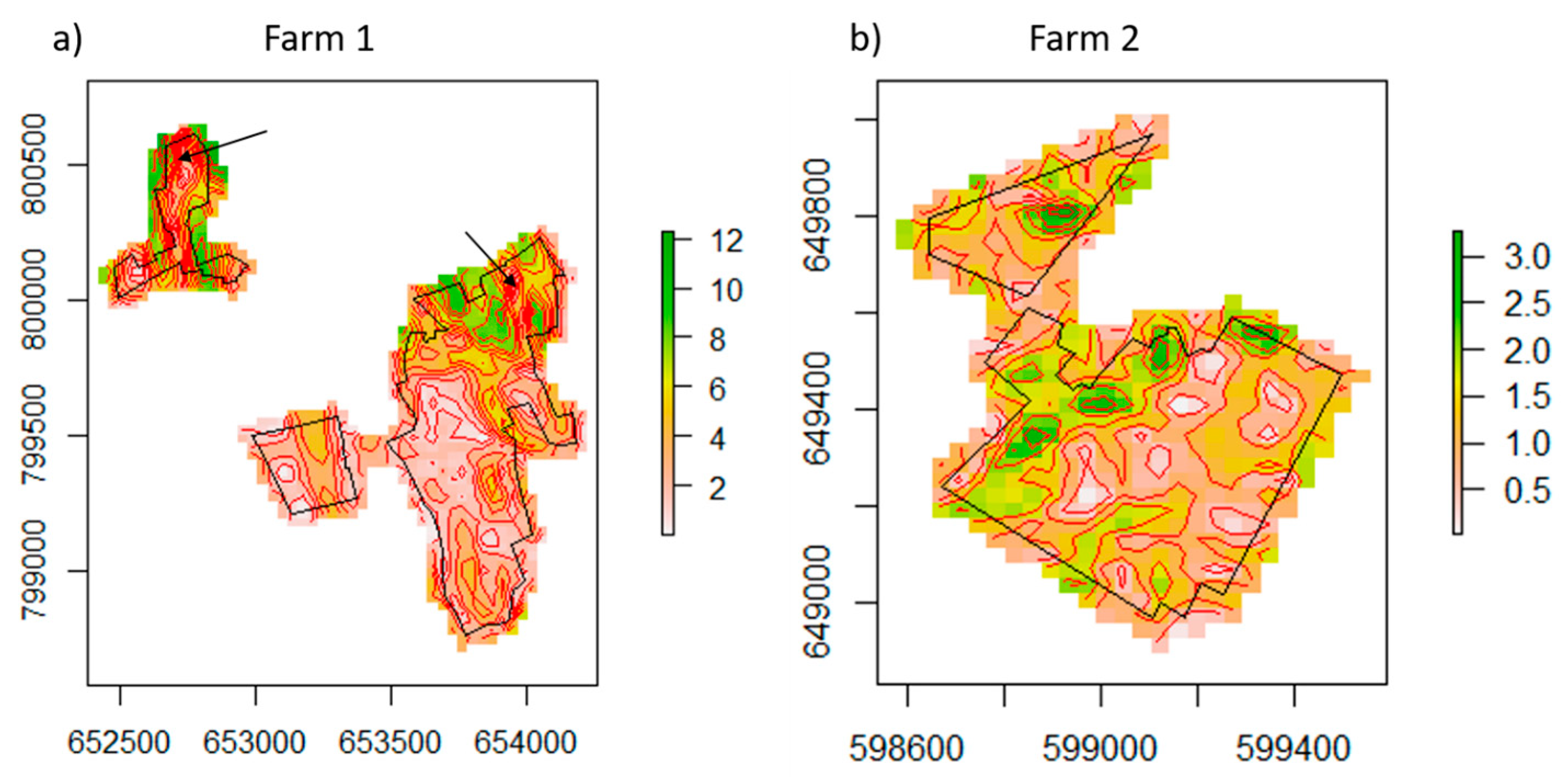

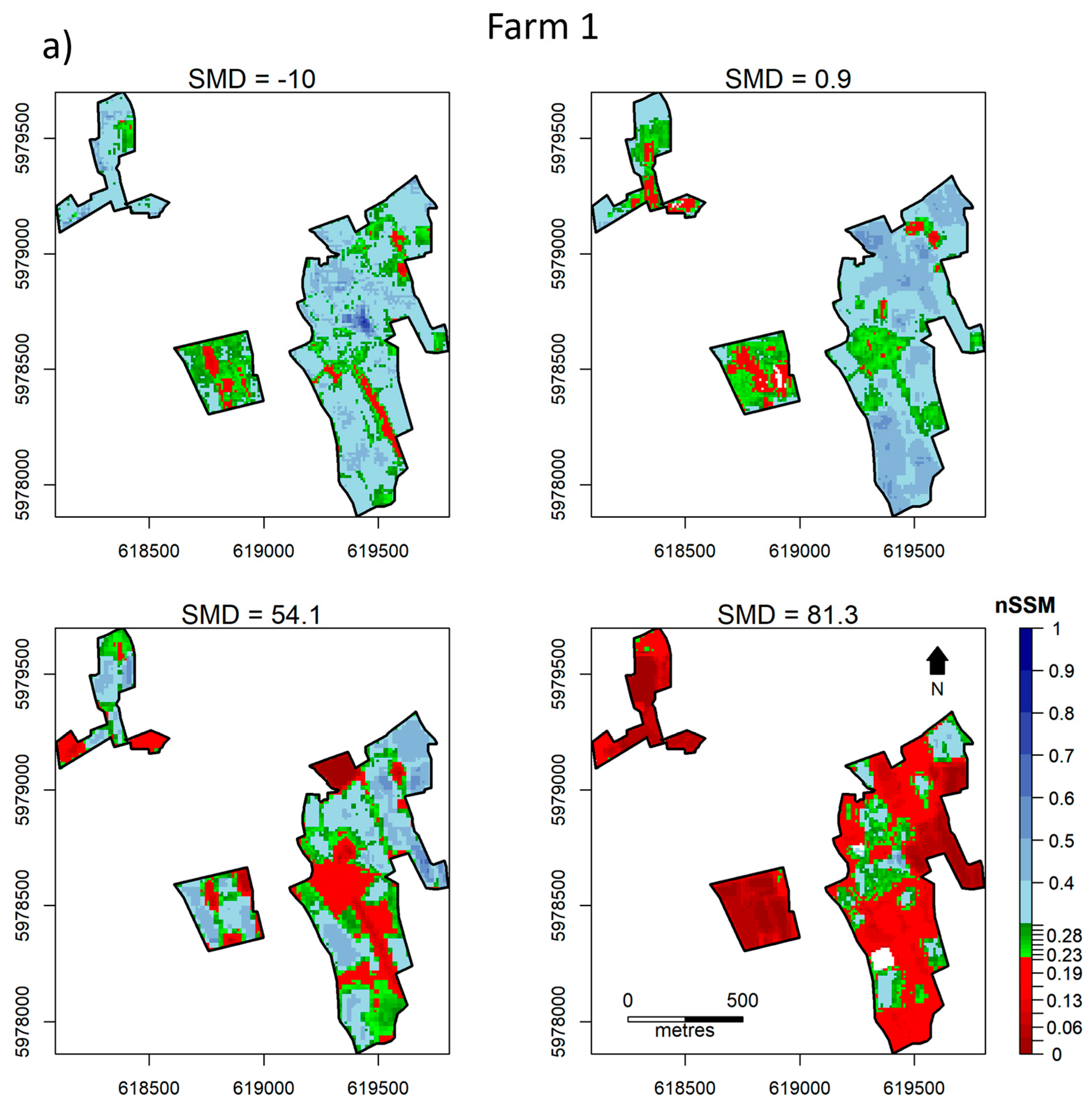
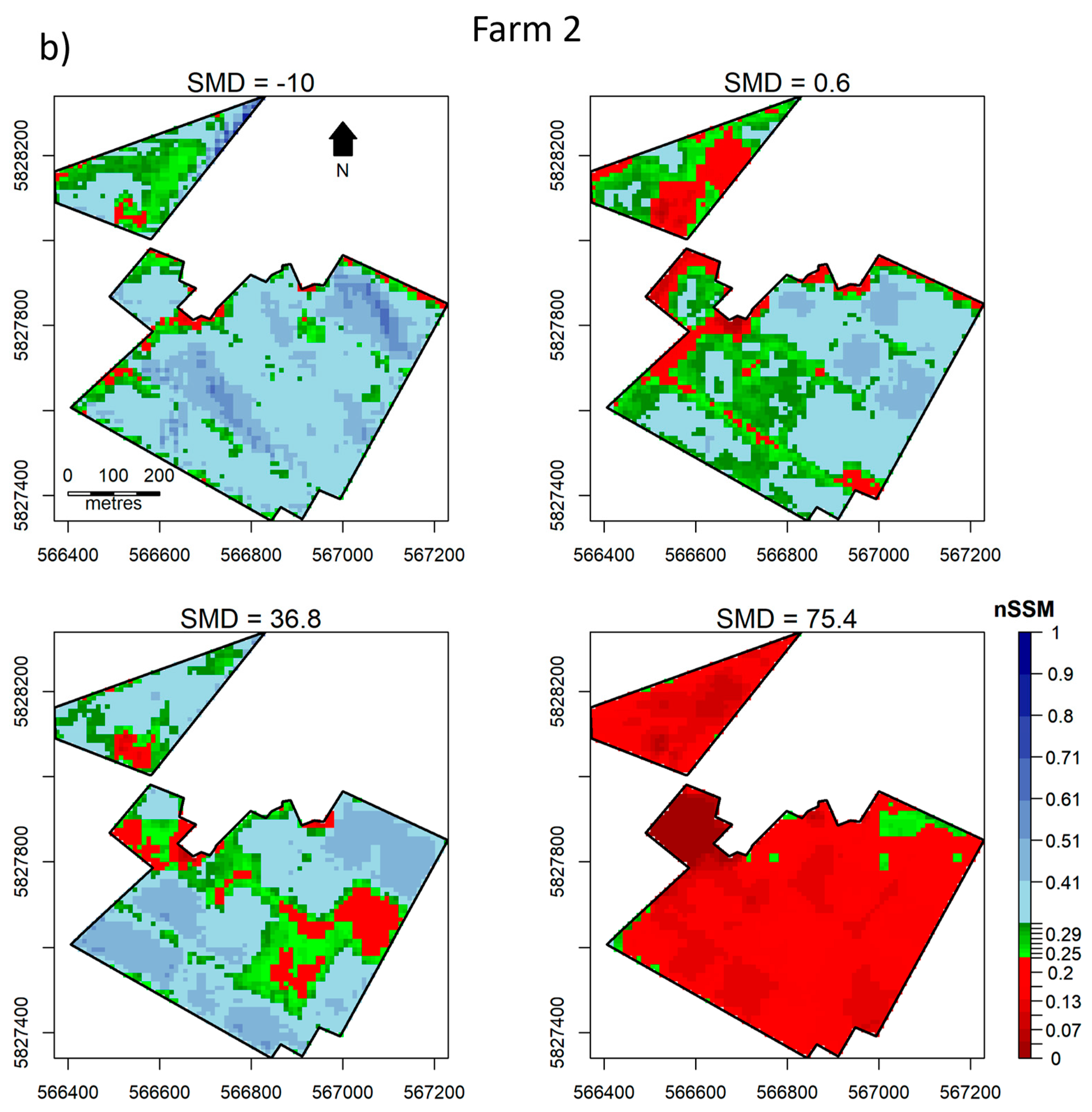
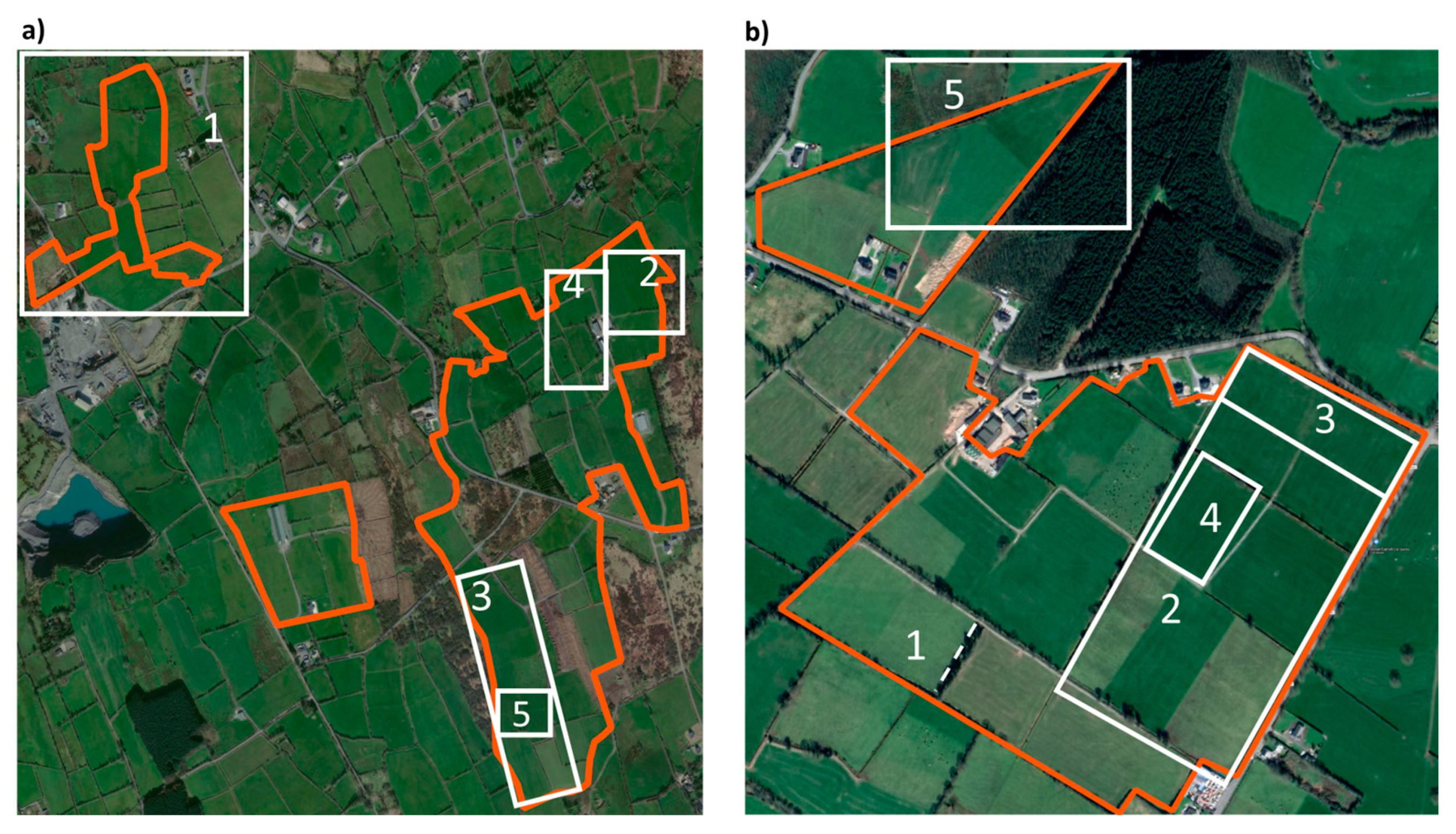
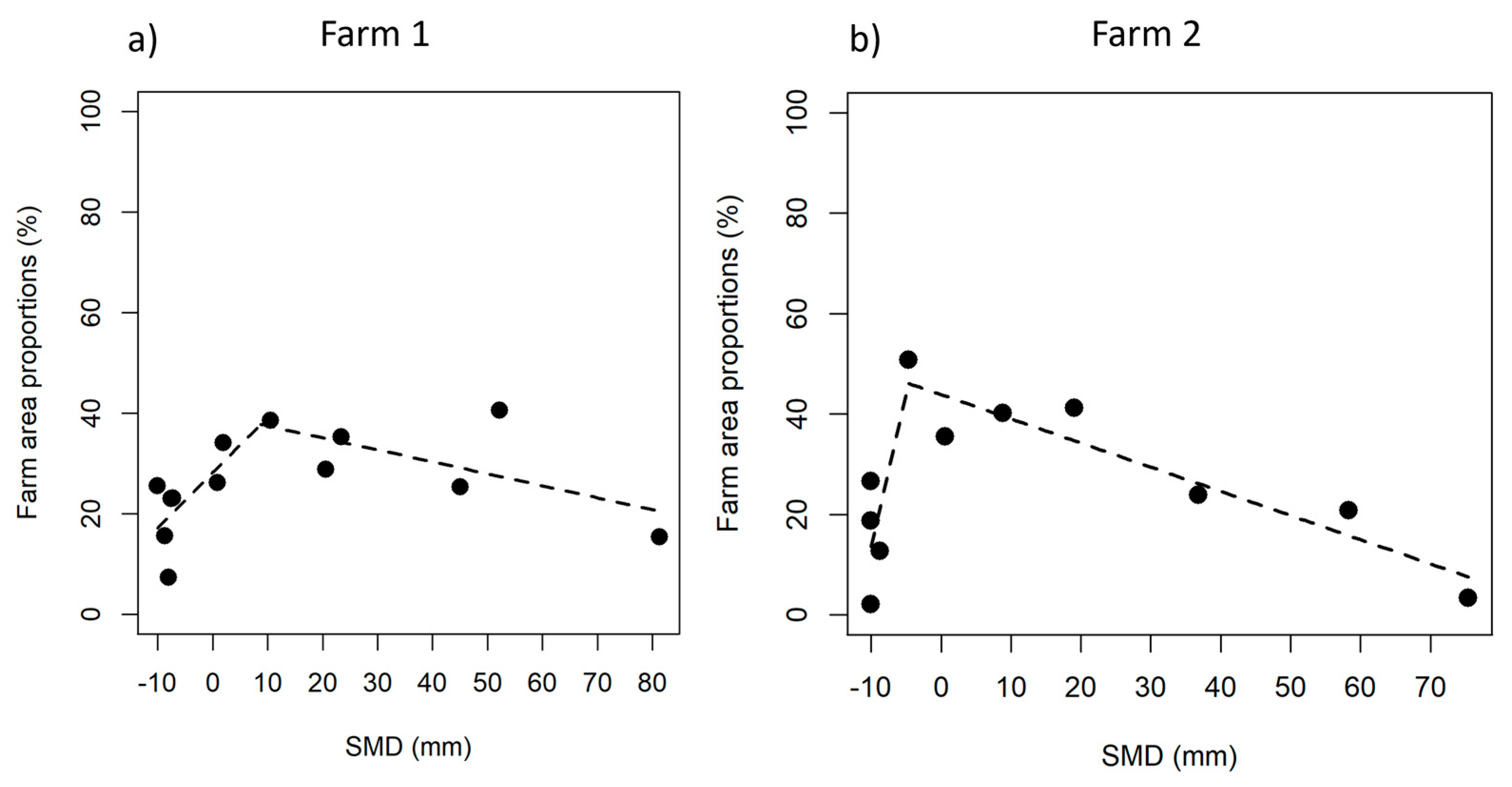
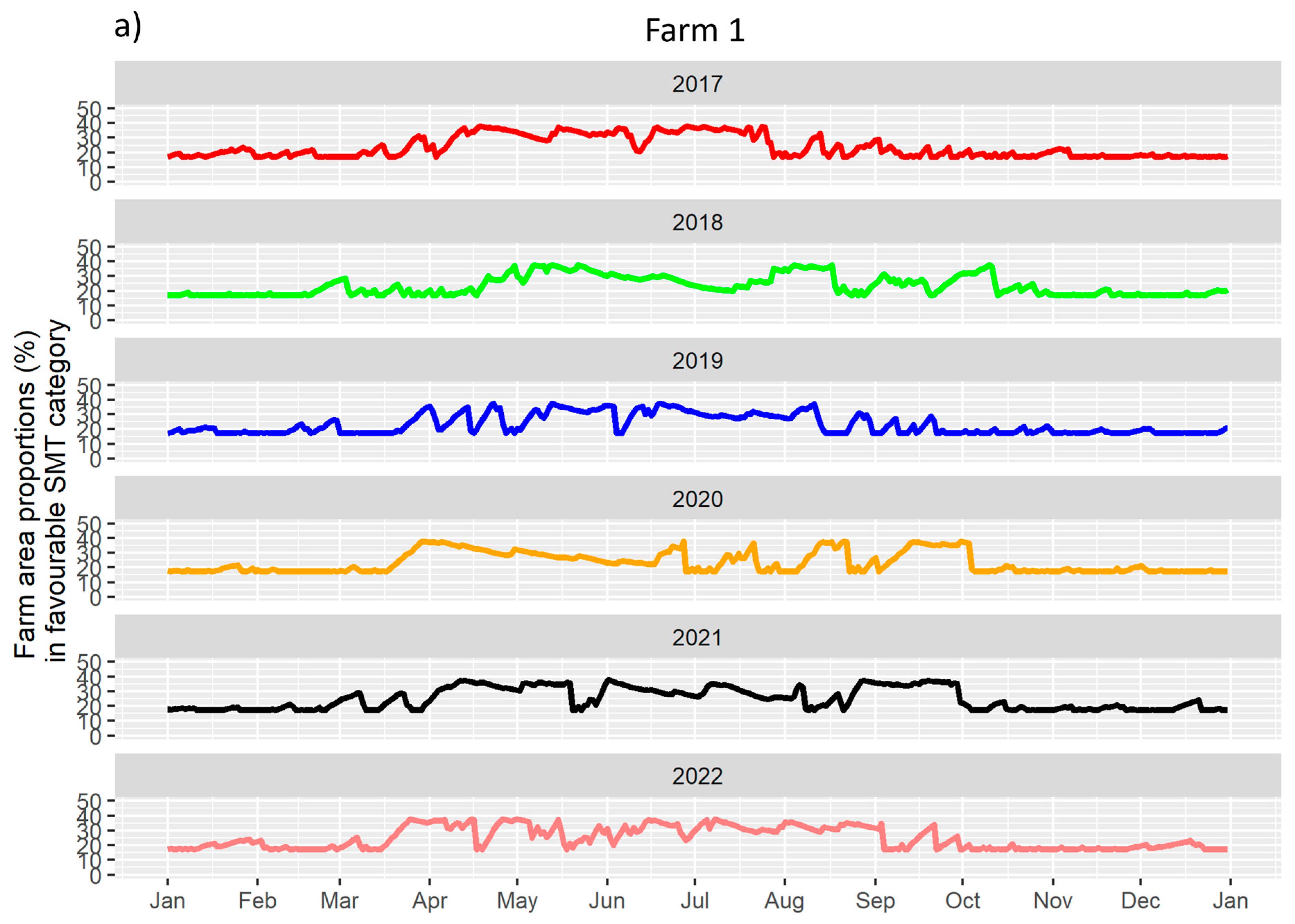

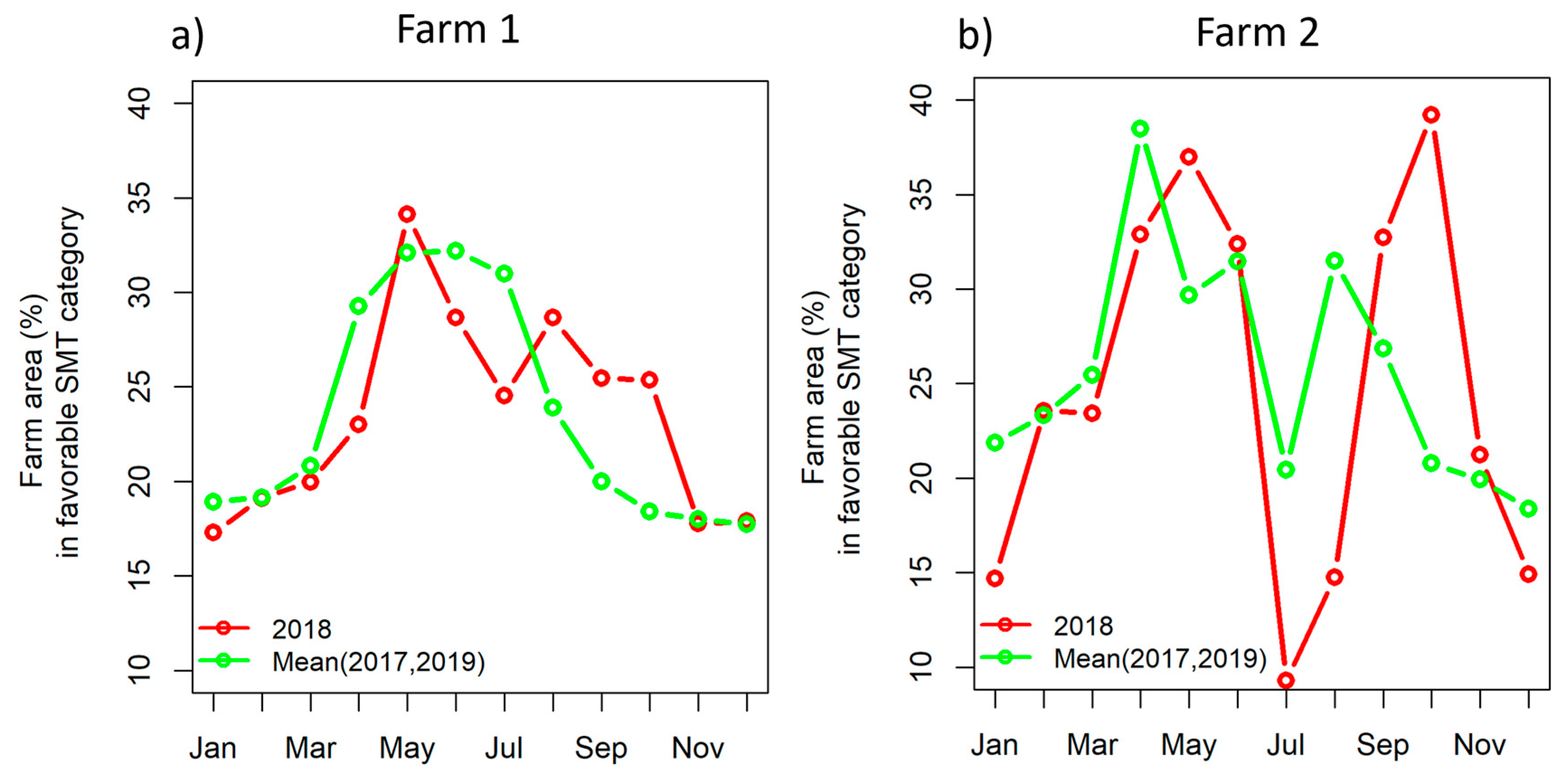

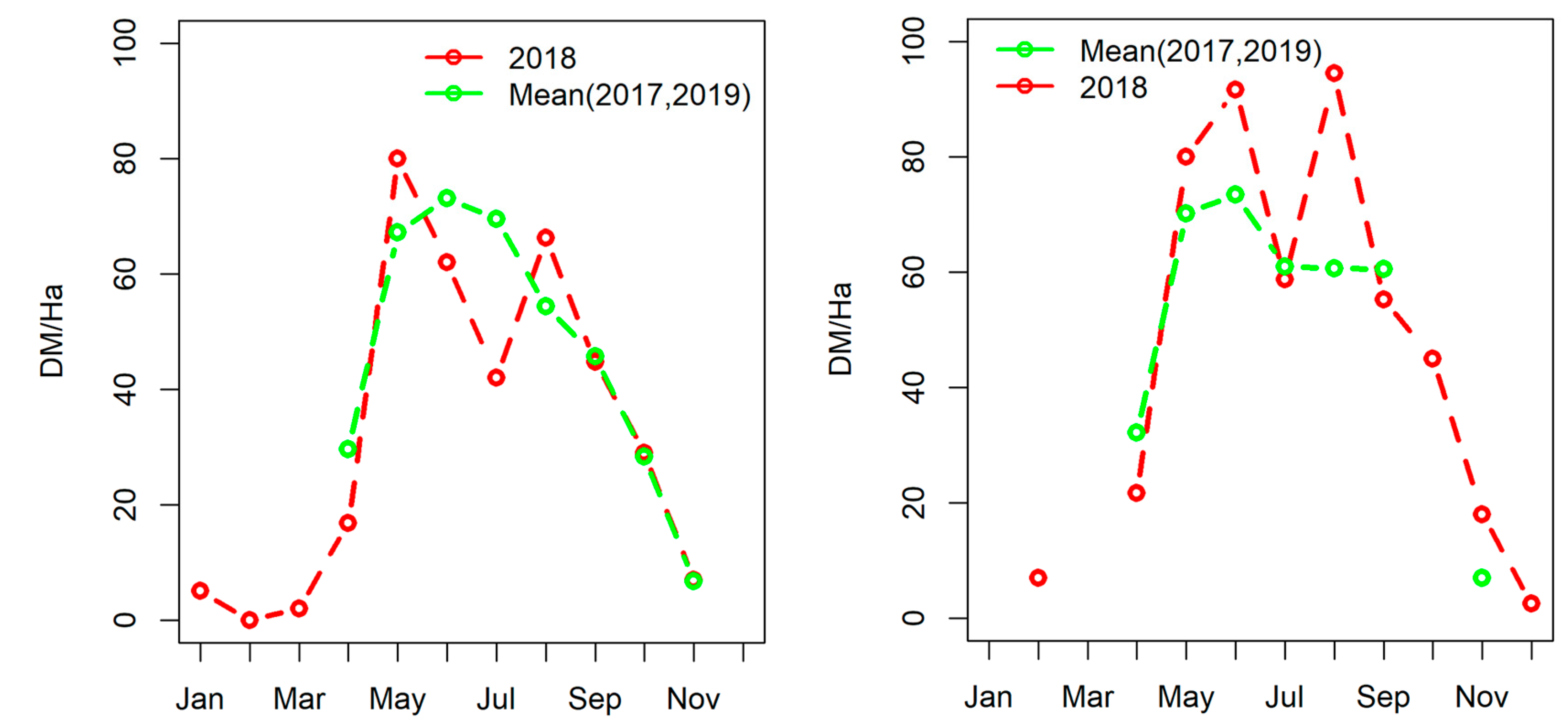
Disclaimer/Publisher’s Note: The statements, opinions and data contained in all publications are solely those of the individual author(s) and contributor(s) and not of MDPI and/or the editor(s). MDPI and/or the editor(s) disclaim responsibility for any injury to people or property resulting from any ideas, methods, instructions or products referred to in the content. |
© 2025 by the authors. Licensee MDPI, Basel, Switzerland. This article is an open access article distributed under the terms and conditions of the Creative Commons Attribution (CC BY) license (https://creativecommons.org/licenses/by/4.0/).
Share and Cite
Basu, R.; Fenton, O.; Misra, G.; Tuohy, P. Optimising Farm Area Allocations Based on Soil Moisture Thresholds: A Comparative Study of Two Dairy Farms with Distinct Soil and Topographic Features. Agriculture 2025, 15, 920. https://doi.org/10.3390/agriculture15090920
Basu R, Fenton O, Misra G, Tuohy P. Optimising Farm Area Allocations Based on Soil Moisture Thresholds: A Comparative Study of Two Dairy Farms with Distinct Soil and Topographic Features. Agriculture. 2025; 15(9):920. https://doi.org/10.3390/agriculture15090920
Chicago/Turabian StyleBasu, Rumia, Owen Fenton, Gourav Misra, and Patrick Tuohy. 2025. "Optimising Farm Area Allocations Based on Soil Moisture Thresholds: A Comparative Study of Two Dairy Farms with Distinct Soil and Topographic Features" Agriculture 15, no. 9: 920. https://doi.org/10.3390/agriculture15090920
APA StyleBasu, R., Fenton, O., Misra, G., & Tuohy, P. (2025). Optimising Farm Area Allocations Based on Soil Moisture Thresholds: A Comparative Study of Two Dairy Farms with Distinct Soil and Topographic Features. Agriculture, 15(9), 920. https://doi.org/10.3390/agriculture15090920






